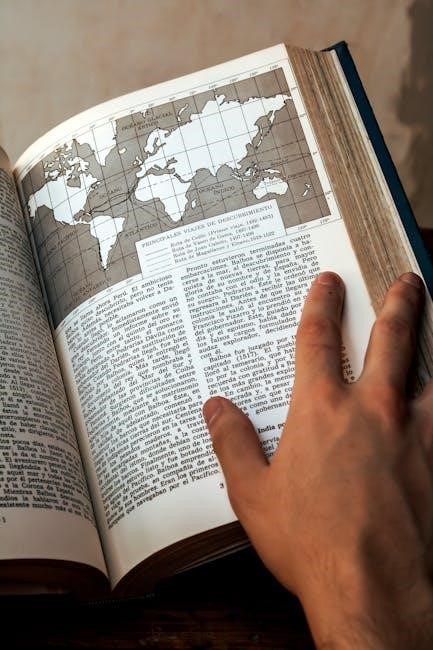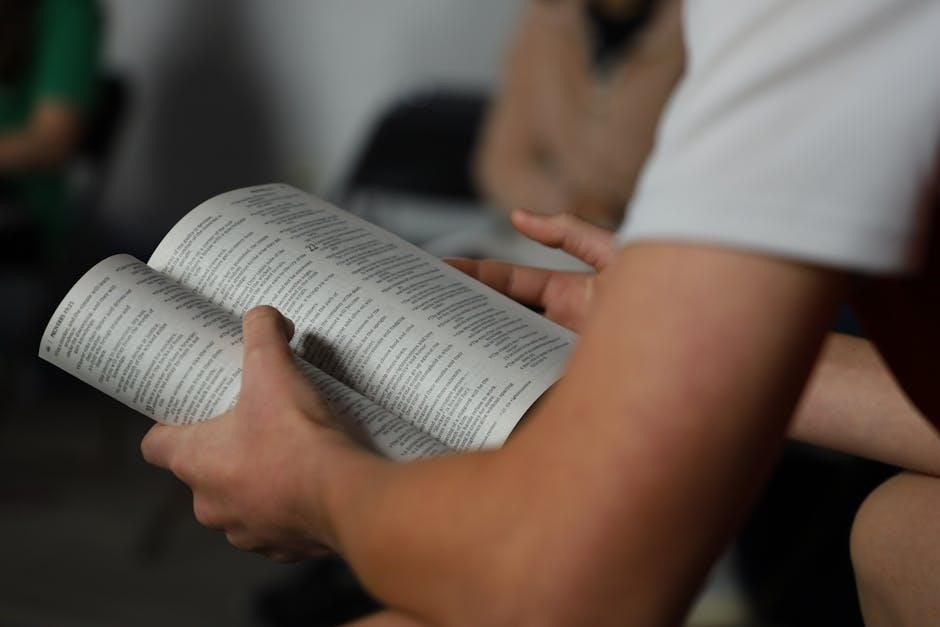Welcome to the FOI Study Guide, your comprehensive resource for mastering fiber optics. This guide provides a structured approach to understanding key concepts, exam preparation, and practical applications, ensuring you’re well-prepared for certification and real-world challenges.
1.1 Importance of the FOI Certification
The FOI certification is a valuable credential for professionals in fiber optics, demonstrating expertise in installation, testing, and maintenance. It enhances career opportunities and industry recognition, ensuring proficiency in handling advanced fiber optic systems. This certification validates your understanding of key concepts, practical skills, and adherence to safety standards, making you a competitive candidate in the telecommunications and networking fields. Achieving FOI certification also signifies your commitment to staying updated with the latest technologies and best practices in fiber optics.
1.2 Overview of the FOI Exam Format
The FOI exam format includes multiple-choice questions and hands-on tasks, assessing both theoretical knowledge and practical skills. The exam covers essential topics like fiber optic installation, testing, and safety protocols. Candidates typically have a set time limit to complete the exam, and a minimum passing score is required. The exam ensures competence in fiber optics, validating your ability to work effectively in the field. Understanding the format helps in preparing strategically for the certification.
1.3 How to Use This Study Guide Effectively
To maximize your learning, start by setting clear goals and creating a study plan. Begin with the fundamentals, progressing logically through each chapter. Engage actively by highlighting key concepts and taking notes. Use practice exams to assess your understanding and identify areas for improvement. Allocate time for hands-on practice with fiber optic tools and equipment. Regularly review and summarize what you’ve learned to reinforce retention. Stay organized, and prioritize consistent study sessions to build confidence and mastery of the material.

Fundamentals of Fiber Optics
Fiber optics involves transmitting data as light signals through thin glass or plastic fibers. It enables high-speed, reliable communication over long distances with minimal signal loss.
2.1 Key Concepts in Fiber Optics
Fiber optics relies on the principle of total internal reflection, where light travels through thin glass or plastic fibers. Understanding optical fibers, including single-mode and multi-mode types, is essential. Key concepts also include optical attenuation, dispersion, and signal transmission principles; Knowledge of optical transmitters, receivers, and amplifiers is fundamental. These components work together to ensure efficient data transmission over long distances.
Fiber optics also involves understanding connectors, splices, and testing tools. Grasping these basics is crucial for installing, maintaining, and troubleshooting fiber optic systems effectively.
2.2 History and Evolution of Fiber Optics
The history of fiber optics began in the 19th century with the discovery of total internal reflection by John Tyndall. In the 20th century, fiber optics evolved rapidly, with the first practical fibers developed in the 1950s. The breakthrough came in 1966 when Charles Kao demonstrated laser light transmission through glass fibers. This innovation led to the first commercial fiber optic communication systems in the 1980s, revolutionizing telecommunications. Today, fiber optics is a cornerstone of global connectivity, enabling high-speed data transmission over long distances with minimal loss.
2.3 Basic Components of Fiber Optic Systems
Fiber optic systems consist of three primary components: the transmitter, optical fiber, and receiver. The transmitter converts electrical signals into light, which travels through the optical fiber. The fiber, made of glass or plastic, guides light via total internal reflection. At the receiving end, the receiver converts the light back into electrical signals. Additional components like connectors, splices, and amplifiers enhance signal transmission and maintenance, ensuring reliable data transfer over long distances.

Fiber Optic Installer (FOI) Certification Process
The FOI certification process involves meeting eligibility criteria, registering for the exam, and preparing effectively. It ensures installers demonstrate competency in fiber optic technologies and applications.
3.1 Eligibility Criteria for the FOI Exam
To qualify for the FOI exam, candidates must meet specific eligibility criteria. Typically, this includes completing approved training programs, having relevant work experience, or demonstrating proficiency in fiber optics. Some certification bodies require a high school diploma or equivalent. Additionally, candidates must submit proper identification and pay the required exam fee. Meeting these criteria ensures candidates are adequately prepared for the exam and the responsibilities of certification.
3.2 Steps to Register for the FOI Certification
Registering for the FOI certification involves several straightforward steps. First, verify your eligibility by reviewing the criteria set by the certification body. Next, create an account on the official registration portal. Select the FOI exam from the available options and complete the required personal and professional information. Upload necessary documents, such as proof of training or work experience. Proceed to payment using an accepted method. Once payment is confirmed, schedule your exam at a convenient time and location. Ensure you review all requirements before finalizing your registration to avoid delays.
3.3 Exam Preparation Strategies
Effective exam preparation requires a structured approach. Begin by creating a study plan tailored to your schedule and learning style. Focus on understanding key concepts rather than memorizing details. Utilize recommended study materials, online courses, and practice exams to gauge your readiness. Dedicate time to hands-on practice with fiber optic tools and simulations. Regularly review and address weak areas to build confidence. Stay motivated by setting achievable goals and maintaining a balanced study routine. Consistent effort and strategic preparation are essential for success in the FOI certification exam.

Optical Fiber Types and Applications
Optical fibers are classified into single-mode and multi-mode types, each suited for specific applications. Single-mode fibers are ideal for long-distance telecommunications, while multi-mode fibers are used in shorter distances and local area networks. Specialized fibers, like polarization-maintaining fibers, are designed for precise applications such as sensing and scientific research. Understanding these types and their applications is crucial for selecting the right fiber for various installations and ensuring optimal performance in fiber optic systems.
4.1 Single-Mode vs. Multi-Mode Fibers
Single-mode fibers have a smaller core diameter, allowing only one light mode to propagate, ensuring high bandwidth and low signal loss over long distances. They are ideal for telecommunications and long-haul networks. Multi-mode fibers have a larger core, supporting multiple light modes, making them suitable for shorter distances and applications like local area networks. Understanding the differences is key for selecting the appropriate fiber type for specific installations, ensuring optimal performance and minimizing signal degradation in fiber optic systems.
4.2 Specialized Fibers (e.g., Polarization-Maintaining Fibers)
Polarization-maintaining fibers are designed to preserve the polarization state of light, minimizing signal distortion in applications like fiber optic sensing and telecommunications. These fibers have a unique core structure that reduces modal interference, ensuring stable transmission. Other specialized fibers include dispersion-shifted, non-zero dispersion, and photonic crystal fibers, each tailored for specific performance needs. Understanding these advanced fiber types is crucial for selecting the right technology for complex optical systems, ensuring optimal signal integrity and system reliability in demanding environments;
4.3 Fiber Optic Cables and Their Uses
Fiber optic cables are bundled fibers protected by layers of shielding and jacketing, designed for various environments. They are used in telecommunications, internet connectivity, and industrial settings, offering high-speed data transmission. Cables vary in fiber count, from simplex to multi-fiber, and are tailored for indoor, outdoor, or underwater applications. Their durability and resistance to interference make them ideal for long-distance communication and harsh conditions, ensuring reliable performance in diverse installation scenarios and applications.

Fiber Optic Connectors and Splices
Fiber optic connectors and splices are critical for maintaining signal integrity. Connectors link fibers, while splices join them permanently or temporarily. They minimize signal loss, ensuring reliable transmission in various applications.
5.1 Types of Fiber Optic Connectors
Fiber optic connectors are essential for linking optical fibers, ensuring precise alignment and minimal signal loss. Common types include SC, LC, ST, and FC connectors. SC connectors are widely used in telecommunications and data centers due to their reliability and high performance. LC connectors are smaller, making them ideal for high-density applications. ST connectors, though older, are still used in industrial environments, while FC connectors are common in older networks and test setups. Each type offers unique features suited to specific applications, ensuring durability and optimal signal transmission.
5.2 Connector Loss and Performance Factors
Connector loss refers to the signal attenuation that occurs when connecting two fiber optic cables. It is measured in decibels (dB) and is influenced by factors such as misalignment, contamination, and connector quality. Proper alignment ensures minimal loss, while dirt or debris can significantly degrade performance. High-quality connectors with precise ferrule tolerances minimize insertion loss. Regular cleaning and inspection of connectors are critical to maintaining optimal performance. Understanding these factors is essential for ensuring reliable and efficient fiber optic systems, particularly in high-speed communication networks where even small losses can impact overall performance.
5.3 Fusion Splicing vs. Mechanical Splicing
Fusion splicing permanently joins two fibers by melting their ends together, creating a strong, reliable connection with minimal signal loss. It is ideal for long-term installations due to its durability and low attenuation. Mechanical splicing, however, holds fibers together without heat, offering flexibility and quicker installation. While it is easier to reconfigure, it may have higher signal loss and is less durable. Choosing the right method depends on application requirements, such as environmental conditions and system performance needs, ensuring optimal network reliability and efficiency.

Fiber Optic Testing and Measurement
Fiber optic testing ensures reliable signal transmission by verifying cable integrity, connector performance, and signal strength. Tools like OTDRs measure fiber length and detect issues, ensuring accuracy and efficiency in network setup and maintenance.
6.1 Essential Fiber Optic Testing Tools
Key tools for fiber optic testing include the Optical Time-Domain Reflectometer (OTDR), used for measuring fiber length and detecting faults. Optical Power Meters measure light intensity, ensuring signal strength. Visual Fault Locators (VFLs) identify breaks using a red laser. Fiber Optic Light Sources emit light at specific wavelengths for testing. Fiber Scopes inspect connector end faces for cleanliness. These tools are vital for diagnosing issues and ensuring optimal system performance, making them indispensable in any fiber optic setup.
6.2 Optical Time-Domain Reflectometer (OTDR) Basics
An OTDR is a critical tool for fiber optic testing, measuring signal backscattered or reflected light. It helps identify faults, such as breaks or connectors, by analyzing signal loss over distance. The OTDR sends a light pulse and records the returning signal, creating a trace. This trace reveals fiber length, attenuation rates, and connection points. It is essential for diagnosing issues in long-haul and metro networks, ensuring reliable fiber optic system performance and accuracy in troubleshooting. Regular use of OTDRs is vital for maintaining optimal network health.
6.3 Power and Loss Measurements
Power and loss measurements are crucial for ensuring fiber optic systems operate efficiently. Optical power meters measure signal strength in dBm or µW, while loss is quantified in decibels (dB). Insertion loss and attenuation are key metrics, indicating signal reduction through components or fibers. Accurate measurements ensure system performance meets specifications. Tools like optical power meters and OTDRs help identify issues. Regular testing prevents signal degradation and ensures compliance with industry standards, maintaining reliable network operation and data integrity. Proper measurement techniques are essential for troubleshooting and optimizing fiber optic installations.

Safety and Best Practices
Safety is crucial when handling fiber optics to prevent injuries and ensure system longevity. Proper handling, storage, and environmental considerations are essential for maintaining integrity and performance.
7.1 Safety Precautions When Handling Fiber Optics
Handling fiber optics requires careful attention to safety to avoid injuries. Always wear protective eyewear to prevent eye damage from laser light or fiber shards. Use gloves to protect hands from cuts when handling glass fibers. Ensure work areas are well-ventilated to avoid inhaling dust or chemicals. Avoid bending or stressing fibers excessively, as they can break and cause injuries. Properly dispose of fiber scraps and chemicals to maintain a safe environment. Follow manufacturer guidelines for tools and materials to minimize risks and ensure compliance with safety standards.
7.2 Proper Handling and Storage of Fiber Optic Cables
Proper handling and storage of fiber optic cables are essential to maintain their performance and longevity. Always handle cables by the jacket or protective covering to avoid direct contact with the fiber. Avoid bending cables beyond their specified radius, as this can cause damage or signal loss. Store cables in a clean, dry environment, away from extreme temperatures and moisture. Use reel stands or cable management systems to prevent tangling or kinking. Regularly inspect cables for signs of wear or damage before installation or use.
7.3 Environmental Considerations
Environmental considerations play a crucial role in fiber optic installations and maintenance. Proper disposal of fiber optic materials, such as cables and connectors, is essential to prevent contamination. Use eco-friendly practices during installations to minimize disruption to natural habitats. Adhere to local regulations regarding cable laying and ensure energy-efficient systems are prioritized. Regularly assess the environmental impact of fiber optic projects and adopt sustainable practices to reduce carbon footprints. This ensures a balance between technological advancement and environmental preservation.

Learning Strategies for FOI Success
Develop a structured study plan, engage in active learning, and apply practical knowledge to reinforce concepts. Stay motivated, manage time effectively, and seek regular feedback to ensure progress.
8.1 Effective Study Habits for Technical Subjects
Mastering technical subjects like fiber optics requires structured study habits. Start by setting clear, achievable goals for each study session. Use diagrams and visuals to grasp complex concepts. Engage in active learning by solving problems and simulating real-world scenarios. Prioritize understanding over memorization, as practical application is key. Schedule regular review sessions to reinforce learning and prevent knowledge gaps. Minimize distractions by dedicating specific times for focused study. Stay organized with detailed notes and reference materials. Consistency and patience are essential for long-term success in technical fields.
8.2 Test-Taking Tips for the FOI Exam
To excel in the FOI exam, adopt strategic test-taking approaches. Begin by thoroughly understanding the exam format and content. Manage your time wisely, allocating equal attention to each question. Skim through the entire exam first to identify easier questions and tackle them early. Eliminate obviously incorrect answers to improve guessing odds. Avoid spending too long on a single question—move forward and revisit if time permits. Stay calm and focused, as stress can hinder performance. Use the process of elimination and logical reasoning to enhance accuracy. Review your answers if time allows to catch any errors.
8.3 Minimizing Study Frustration
Studying for the FOI exam can be challenging, but there are ways to minimize frustration. Break your study material into manageable sections, focusing on one topic at a time. Set achievable goals and celebrate small milestones to stay motivated. Use active learning techniques, such as self-quizzing or summarizing concepts, to engage with the material. Maintain a study schedule and take regular breaks to avoid burnout. Seek clarification on difficult topics through forums, mentors, or additional resources. Stay positive and remind yourself of your progress to keep frustration at bay.

Resources for Advanced Learning
Explore recommended books like Bill Woodward’s FOI Certification Exam Guide, online courses, and practice exams to deepen your understanding and refine your fiber optics skills effectively.
9.1 Recommended Study Materials and Books
For a strong foundation, consider Fiber Optics Installer (FOI) Certification Exam Guide by Bill Woodward, offering detailed insights and practice questions. The Learning Statement Reference Guide for Airman Knowledge Testing is also valuable, with listings of key concepts. Additionally, CFI Notes and Lesson Plans cover essential maneuvers and tasks. These resources, often available in PDF formats, provide comprehensive coverage of fiber optics and certification requirements, ensuring thorough preparation for both theoretical and practical aspects of the FOI exam.

9.2 Online Courses and Tutorials
Enhance your knowledge with online courses tailored for FOI certification. Platforms like the Learning Hub for American Airlines offer specialized tutorials. The Fiber Optics Installer (FOI) Certification Exam Guide by Bill Woodward is available online, providing in-depth study materials. Additionally, websites like Coursera and Udemy host courses on fiber optics, offering hands-on training and simulations. These resources ensure a well-rounded understanding of fiber optics, combining theoretical knowledge with practical skills essential for exam success and real-world applications.
9.3 Practice Exams and Simulations
Practice exams and simulations are crucial for assessing your readiness for the FOI certification. Utilize resources like the FOI Worksheet and the Learning Statement Reference Guide for targeted practice. Online platforms offer realistic simulations, mimicking actual exam conditions. These tools help identify weak areas and refine test-taking strategies. Regular practice builds confidence and ensures a thorough understanding of fiber optics concepts. Make use of these resources to enhance your preparation and achieve optimal results on exam day.
Mastering fiber optics requires dedication and practice. This guide equips you with essential knowledge for the FOI certification. Review key concepts, manage time, and stay motivated for exam success. Utilize the FOI Worksheet and online simulations for final preparation;
10.1 Reviewing Key Concepts
Reviewing key concepts is essential for reinforcing your understanding of fiber optics. Focus on summarizing notes, re-reading challenging topics, and applying knowledge through practice problems. Use flashcards or concept maps to visualize relationships between ideas. Regularly revisit fundamental principles, such as fiber types, connectors, and testing methods, to ensure a strong foundation. Engage in active learning by teaching concepts to others or explaining them aloud. Consistent review prevents knowledge gaps and builds confidence for the exam. Prioritize areas where you feel less confident to achieve comprehensive mastery.
10.2 Time Management for Exam Day
Effective time management on exam day is crucial for success. Allocate a set amount of time to each question based on its difficulty and point value. Skim through the entire exam first to identify easier questions and tackle them early to build confidence. Avoid spending too long on a single question—move on and return if time permits. Use techniques like the Pomodoro method to maintain focus and minimize burnout. Ensure you leave a few minutes at the end to review your answers and make necessary adjustments. Stay calm and systematic to maximize your performance.
10.3 Staying Motivated and Confident
Staying motivated and confident is key to excelling in your FOI certification journey. Set realistic goals and celebrate small achievements to maintain momentum. Surround yourself with supportive resources and remind yourself of your progress. Positive affirmations and a growth mindset can help overcome self-doubt. Stay informed about exam content and practice consistently to build confidence. Embrace challenges as learning opportunities and trust in your preparation. A confident mindset will not only enhance your performance but also reduce exam-day anxiety, ensuring you approach the test with clarity and assurance.
